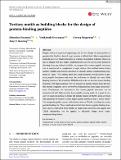Tertiary motifs as building blocks for the design of protein‐binding peptides
Author(s)
Swanson, Sebastian; Sivaraman, Venkatesh; Grigoryan, Gevorg; Keating, Amy E
DownloadPublished version (9.293Mb)
Publisher with Creative Commons License
Publisher with Creative Commons License
Creative Commons Attribution
Terms of use
Metadata
Show full item recordAbstract
Despite advances in protein engineering, the de novo design of small proteins or peptides that bind to a desired target remains a difficult task. Most computational methods search for binder structures in a library of candidate scaffolds, which can lead to designs with poor target complementarity and low success rates. Instead of choosing from pre-defined scaffolds, we propose that custom peptide structures can be constructed to complement a target surface. Our method mines tertiary motifs (TERMs) from known structures to identify surface-complementing fragments or "seeds." We combine seeds that satisfy geometric overlap criteria to generate peptide backbones and score the backbones to identify the most likely binding structures. We found that TERM-based seeds can describe known binding structures with high resolution: the vast majority of peptide binders from 486 peptide-protein complexes can be covered by seeds generated from single-chain structures. Furthermore, we demonstrate that known peptide structures can be reconstructed with high accuracy from peptide-covering seeds. As a proof of concept, we used our method to design 100 peptide binders of TRAF6, seven of which were predicted by Rosetta to form higher-quality interfaces than a native binder. The designed peptides interact with distinct sites on TRAF6, including the native peptide-binding site. These results demonstrate that known peptide-binding structures can be constructed from TERMs in single-chain structures and suggest that TERM information can be applied to efficiently design novel target-complementing binders.
Date issued
2022-06Department
Massachusetts Institute of Technology. Department of Biology; Massachusetts Institute of Technology. Department of Biological Engineering; Koch Institute for Integrative Cancer Research at MITJournal
Protein Science
Publisher
Wiley
Citation
Swanson, Sebastian, Sivaraman, Venkatesh, Grigoryan, Gevorg and Keating, Amy E. 2022. "Tertiary motifs as building blocks for the design of protein‐binding peptides." Protein Science, 31 (6).
Version: Final published version